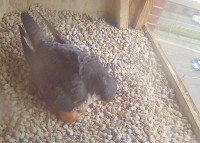Lawrence Peregrines: as hatching approaches!
May 6, 2018 in In the Nest Box, lawrence peregrines, Peregrine Falcons Eastern Massachusetts, Peregrine Falcons Massachusetts
The peregrines started the day off with overcast skies, light rain, winds from SW at 5MPH, and temps in low 60’s. The day ahead calls for showers, mainly before 1pm. High near 64. Light and variable wind becoming northeast around 6 mph in the afternoon. Chance of precipitation is 90%. New precipitation amounts of less than a tenth of an inch possible.
 As hatching approaches, the adults often become more aggressive. During the early nestling stages the young require almost constant brooding, which can be hard to distinguish from incubation. The main difference is that after a food exchange, the female takes the prey into the nest rather than eating outside (she may pluck it before entering the nest box). During the early nestling stage most females do the majority of feeding. Males provide food, and may brood young during the female’s absence.
As hatching approaches, the adults often become more aggressive. During the early nestling stages the young require almost constant brooding, which can be hard to distinguish from incubation. The main difference is that after a food exchange, the female takes the prey into the nest rather than eating outside (she may pluck it before entering the nest box). During the early nestling stage most females do the majority of feeding. Males provide food, and may brood young during the female’s absence.
After approximately two weeks, depending on ambient temperature and number of chicks, the young no longer need constant brooding. Therefore, both adults are often outside the nest box for extended periods. Without the falcon cam, and if viewing from a distance, this might easily mistaken for nest failure. Depending on size of prey and number of young, the nest may only be visited a few times a day by the adults. For nests in the wild, clues to presence of young include continued territoriality by adults, absence of courtship behavior, frequent hunting attempts, sometimes hunger screams of young, and, of course, prey deliveries.
As the young age, they begin eating on their own, and sometimes a prey delivery is extremely brief. Also, late in the nestling stage the female hunts, and the male as well as the female feeds young. Some males are absent from the immediate nest area most of the day, either hunting or perched out of sight, except when delivering prey. With no falcon cam, clues to failure include either adult eating full meals without delivering food to the eyrie, decreased territoriality and presence at the cliff or resumed courtship behavior if recycling is occurring, and frequent wailing.
Literature Cited:
Cade, T. J., J. H. Enderson and J. Linthicum. 1996a. Guide to Management of Peregrine Falcons at the eyrie. Boise, ID: The Peregrine Fund, Inc. (Excerpt: Linthicum, Janet. Observing Breeding Behavior)
